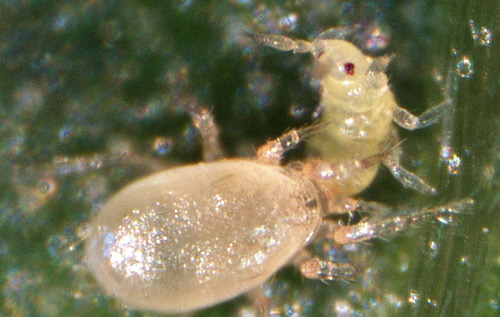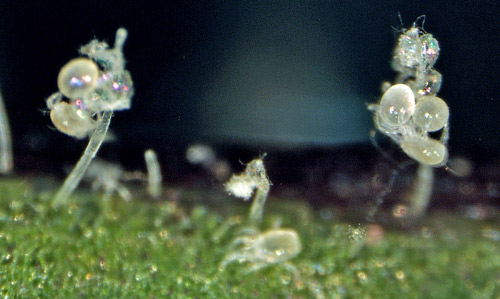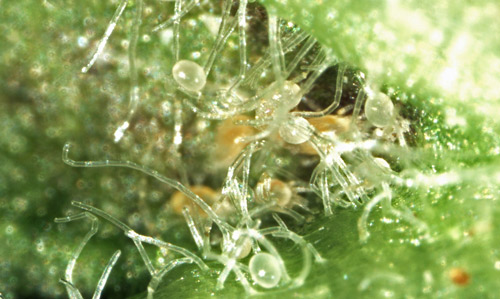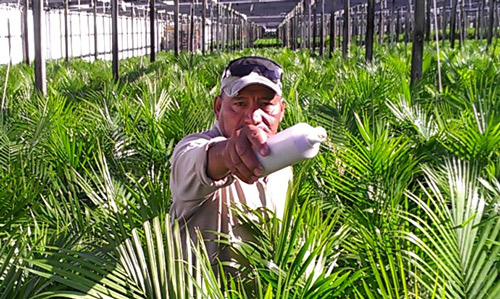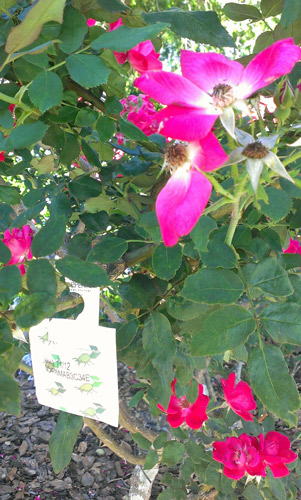common name: Swirski mite (suggested common name)
scientific name: Amblyseius swirskii Athias-Henriot (Arachnida: Mesostigmata: Phytoseiidae)
Introduction - Synonymy - Distribution - Description and Biology - Biology - Host Range - Selected References
Introduction (Back to Top)
Amblyseius swirskii is a beneficial predatory mite endemic to the Eastern Mediterranean region. This species is considered a generalist predator, and readily consumes small soft-bodied arthropod pest species as well as pollen or plant exudates. Amblyseius swirskii has attracted substantial interest as a biological control agent of mites, thrips and whiteflies in greenhouse and nursery crops and is currently reared and sold commercially in Europe and North America for this purpose.
Figure 1. Adult Amblyseius swirskii feeding on thrips larvae. Photograph by Steven Arthurs, University of Florida.
Synonymy (Back to Top)
Amblyseius rykei
Neoseiulus swirskii
Typhlodromips swirskii
The multiple species synonyms in the Phytoseiidae are a result of identifications derived from single specimens, poorly defined morphological characters and lack of technical skills in phytoseiid taxonomy.
Distribution (Back to Top)
Amblyseius swirskii is native to Israel, Italy, Cyprus, Turkey, Greece and Egypt, and can be found on various crops including apples, apricot, citrus, vegetables and cotton (EPPO 2013). In North America it was first released in 1983 for control of citrus pests in California. Since 2005, Amblyseius swirskii has been released or tested as a biological control agent in many European countries, as well as North America, North Africa, China, Japan and Argentina (Arthurs et al. 2009, Cedola and Polack 2011, EPPO 2013, Kade et al. 2011, Sato and Mochizuki 2011, Chen et al. 2011). Hence, in recent years, the range of Amblyseius swirskii may have expanded considerably in areas with suitable climatic conditions for its survival.
Description (Back to Top)
Amblyseius swirskii belongs to the Phytoseiidae family, which are characterized by long legs, with the front pair pointing forward and relatively few hairs (< 20 pairs) on their back. The color of mites may vary from deep red to pale yellow depending on the prey items eaten. Mites feeding on thrips and whitefly are generally pale yellow to pale tan.
Amblyseius swirskii cannot be readily distinguished from some other phytoseiid mites (such as Amblyseius barkeri, Amblyseius andersoni, or Neoseiulus californicus) with the naked eye, and positive identification requires examination of slide mounted specimens under a microscope. Length and position of setae (small bristles) on dorsal surface of adults are important morphological characters for identification of phytoseiid mites.
Like other mites, Amblyseius swirskii has five life stages: egg, larva, protonymph, deutonymph and adult.
Adults: Adults are pear-shaped, 0.5 mm (1/50th inch) in length with an unsegmented body and four pairs of legs; males may be slightly smaller than females.
Eggs: Eggs are oval-shaped, pale-whitish and approximately 0.15 mm (1/150th inch) in length. Amblyseius swirskii lays eggs on the underside of plant leaves, mainly at the intersection of main and lateral ribs. Females prefer to lay eggs on leaf hairs (trichomes) near plant domatia (small hairy tufts or pockets found on the lower surface of some leaves), which may be an adaptation to avoid egg predators.
Immature stages: Larvae are pale white to nearly transparent in color and only have three pairs of legs. The protonymph (2nd stage) and deutonymph (3rd stage) have four pairs of legs and are darker than the larvae.
Figure 2. Egg of Amblyseius swirskii laid on leaf trichome; emerged (empty) egg is visible in the lower left corner. Photograph by Mahmut Doğramaci, University of Florida.
Figure 3. Larva of Amblyseius swirskii - note only three pairs of legs. Photograph by Mahmut Doğramaci, University of Florida.
Figure 4. Amblyseius swirskii larvae emerging from eggs. Photograph by Mahmut Doğramaci, University of Florida.
Biology (Back to Top)
Amongst phytoseiids, Amblyseius swirskii is considered a Type III generalist, with a broader host range and reduced tendency to aggregate in response to prey compared to Type I and II species (Croft et al. 2004). In addition to arthropod prey, Amblyseius swirskii can survive and reproduce on various pollens and gain sustenance from plant nectars, which may allow them to persist during periods of low pest density and improve their effectiveness as biological control agents (Ragusa and Swirski 1975). Amblyseius swirskii is adapted to warmer and humid sub-tropical climates and may be less effective in cooler conditions and at reduced relative humidity.
Development of Amblyseius swirskii is influenced by type of food (prey, pollen, plant exudates), availability of food and environmental conditions. Mites develop between 18°C and 36°C at 60% relative humidity (Lee and Gillespie 2011). Feeding on prey, the egg to adult development period at 25°C is around five days (Park et al. 2010). Amblyseius swirskii feeding on live prey develop faster and lay more eggs when compared with pollen-feeding Amblyseius swirskii; for example, females laid 26 and 38 eggs on pollen and mite diets, respectively (Park et al. 2011). When not actively hunting, Amblyseius swirskiii are typically found on the underside of leaves along the midrib or in other protected locations such as domatia.
Figure 5. Leaf domatia of pepper plant containing different life stages of Amblyseius swirskii. Eggs are on outer trichomes and mites are inside pocket of domatia. Photograph by Mahmut Doğramaci, University of Florida.
Host Range (Back to Top)
Amblyseius swirskii is documented to feed and reproduce on a wide range of prey from several orders, including thrips (western flower, onion, melon, and chilli), whiteflies (greenhouse and silverleaf) and plant feeding mites (spider, broad and eriophyoid) (Calvo et al. 2011, Doğramaci et al. 2011, Nomikou et al. 2001, Onzo et al. 2012, Stansly and Castillo 2010, Wimmer et al. 2008, Xiao et al. 2012). Amblyseius swirskii mainly feeds on the immature stages of thrips and whitefly, although it also attacks the adult stages of smaller pest species (Arthurs et al. 2009). A recent study documented Amblyseius swirskii feeding and probably reproducing on immature Asian citrus psyllids (Juan-Blasco et al. 2012).
Figure 6. Amblyseius swirskii feeding on adult chilli thrips. Photograph by Steven Arthurs, University of Florida.
Economic Importance (Back to Top)
Amblyseius swirskii is commonly used to control whitefly and thrips in greenhouse vegetables (especially cucumber, pepper and eggplant) and some ornamental crops, in Europe and North America (Buitenhuis et al. 2010, Messelink et al. 2006). Since Amblyseius swirskii is not susceptible to diapause it can be used throughout much of the season provided daytime temperatures regularly exceed 22°C. The mites are released directly in the crops in bran or vermiculite carriers sprinkled on the leaves or substrates, or may be broadcast via air blast (Buitenhuis et al. 2010, Opit et al. 2005). The recommended release rates are typically between 25 and 100 mites per m² depending on pest species, pest density, and crop. Recent research suggests that the effectiveness of Amblyseius swirskii as a biological control agent may be reduced when multiple pest species are present. Kumar et al. (2016) noted that Amblyseius swirskii provided better control on the foliage of pepper plants, when compared with the flowers. Similarly, Kakkar et al. (2016) reported that in a cucumber field, Amblyseius swirskii fed preferentially and significantly suppressed melon thrips on leaves, but didn’t provide effective control of common blossom thrips inhabiting cucumber flowers.
Figure 7. Commercial preparation of predatory mites in vermiculate carrier. Photograph by Bill Lewis, Delray Plants.
Figure 8. Commercial preparation of predatory mites in carrier being hand-applied to ornamental palms. Photograph by Bill Lewis, Delray Plants.
Figure 9. Commercial preparation of predatory mites being air applied (blown) on to ornamental palms. Photograph by Bill Lewis, Delray Plants.
Slow-release sachets (breeding systems) that contain a substitute prey (bran mite) have been developed, and allow gradual release of predators through a small hole in the sachet over several weeks. These sachets are water resistant and provide resources for the reproducing mites during release period. The use of Amblyseius swirskii may be compatible with certain, but not all, insecticides or other biocontrol agents (Colomer et al. 2011, Doğramaci et al. 2011). In its natural range, Amblyseius swirskii is an important predator of mites and other pests on citrus and other subtropical crops.
Figure 10. Slow-release sachet of predatory mites hung on a rose plant. Photograph by Steven Arthurs, University of Florida.
Selected References (Back to Top)
- Arthurs S, McKenzie CL, Chen J, Doğramaci M, Brennan M, Houben K, Osborne L. 2009. Evaluation of Neoseiulus cucumeris and Amblyseius swirskii (Acari: Phytoseiidae) as biological control agents of chilli thrips, Scirtothrips dorsalis (Thysanoptera: Thripidae) on pepper. Biological Control 49: 91-96.
- Buitenhuis R, Shipp L, Scott-Dupree C. 2010. Dispersal of Amblyseius swirskii Athias-Henriot (Acari: Phytoseiidae) on potted greenhouse chrysanthemum. Biological Control 52: 110-114.
- Calvo FJ, Bolckmans K, Belda JE. 2011. Control of Bemisia tabaci and Frankliniella occidentalis in cucumber by Amblyseius swirskii. Biocontrol 56: 185-192.
- Cedola C, Polack A. 2011. First record of Amblyseius swirskii (Acari: Phytoseiidae) from Argentina. Revista de la Sociedad Entomologica Argentina 70: 375-378.
- Chen X, Zhang Y, Ji J, Lin J. 2011. Experimental life table for population of Amblyseius swirskii (Athias-Henriot) fed on Tetranychus truncatus (Ehara). Fujian Journal of Agricultural Sciences 3: 018.
- Colomer I, Aguado P, Medina P, Heredia RM, Fereres A, Belda JE, Vinuela E. 2011. Field trial measuring the compatibility of methoxyfenozide and flonicamid with Orius laevigatus Fieber (Hemiptera: Anthocoridae) and Amblyseius swirskii (Athias-Henriot) (Acari: Phytoseiidae) in a commercial pepper greenhouse. Pest Management Science 67: 1237-1244.
- Croft BA, Blackwood JS, McMurtry JA. 2004. Classifying life-style types of phytoseiid mites: diagnostic traits. Experimental and Applied Acarology 33: 247-260.
- Doğramaci M, Arthurs S., Mckenzie CL, Chen J, McKenzie C, Irrizary F, Osborne, L. 2011. Management of chilli thrips Scirtothrips dorsalis (Thysanoptera: Thripidae) on peppers by Amblyseius swirskii (Acari: Phytoseiidae) and Orius insidiosus (Hemiptera: Anthocoridae). Biological Control 59: 340-347.
- EPPO (European and Mediterranean Plant Protection Organization). 2013. Commercially used biological control agents - Arachnida, Acarina. (22 April 2016)
- Juan-Blasco M, Qureshi JA, Urbaneja A, Stansley PA. 2012. Predatory mite, Amblyseius swirskii (Acari Phytoseiidae), for biological control of asian citrus psyllid, Diaphorina citri (Hemiptera: Psyllidae). Florida Entomologist 95: 543-551.
- Kade N, Gueye-Ndiaye A, Duverney, C, Moraes G. J. 2011. Phytoseiid mites (Acari: Phytoseiidae) from Senegal. Acarologia 51: 133-138.
- Kakkar G, Kumar V, Seal DR, Liburd OE, Stansly P. 2016. Predation by Neoseiulus cucumeris and Amblyseius swirskii on Thrips palmi and Frankliniella schultzei on cucumber. Biological Control 92: 85-91.
- Kumar V, McKenzie CL, Avery PB, Osborne L. 2016. Ornamental pepper banker plants: Can we bank on them? Pest Management Science (in press).
- Lee HS, Gillespie DR. 2011. Life tables and development of Amblyseius swirskii (Acari: Phytoseiidae) at different temperatures. Experimental and Applied Acarology 53: 17-27.
- Messelink GJ, Van Steenpaal EF, Ramakers PMJ. 2006. Evaluation of phytoseiid predators for control of western flower thrips on greenhouse cucumber. BioControl 51: 753-768.
- Nomikou M, Janssen A, Schraag R, Sabelis MW. 2001. Phytoseiid predators as potential biological control agents for Bemisia tabaci. Experimental and Applied Acarology 25: 271-291.
- Onzo A, Houedokoho AF, Hanna R. 2012. Potential of the predatory mite, Amblyseius swirskii to suppress the broad mite, Polyphagotarsonemus latus on the gboma eggplant, Solanum macrocarpon. Journal of Insect Science. 12: 7. Available online: insectscience.org/12.7
- Opit GP, Nechols JR, Margolies DC, Williams KA. 2005. Survival, horizontal distribution, and economics of releasing predatory mites (Acari: Phytoseiidae) using mechanical blowers. Biological Control 33: 344-351.
- Park HH, Shipp L, Buitenhuis R. 2010. Predation, development and oviposition by the predatory mite Amblyseius swirskii (Acari: Phytoseiidae) on tomato russet mite (Acari: Eriophyidae). Journal of Economic Entomology 103: 563-569.
- Park HH, Shipp L, Buitenhuis R, Ahn JJ. 2011. Life history parameters of a commercially available Amblyseius swirskii (Acari: Phytoseiidae) fed on cattail (Typha latifolia) pollen and tomato russet mite (Aculops lycopersici). Journal of Asia-Pacific Entomology 14: 497-501.
- Ragusa S, Swirski E. 1975. Feeding habits development and oviposition of the predaceous mite Amblyseius swirskii Acarina Phytoseiidae on pollen of various weeds. Israel Journal of Entomology. 15: 55-62.
- Sato Y, Mochizuki A. 2011. Risk assessment of non-target effects caused by releasing two exotic phytoseiid mites in Japan: can an indigenous psytoseiid mite become IG prey? Experimental and Applied Acarology 54: 319-329.
- Stansly PA, Castillo JA. 2010. Control of broadmites, spidermites, and whiteflies using predaceous mites in open-field pepper and eggplant. Proceedings of the Florida State Horticultural Society 122: 253-257.
- Wimmer D, Hoffman D, Schausberger P. 2008. Prey suitability of western flower thrips, Frankliniella occidentalis, and onion thrips, Thrips tabaci, for the predatory mite Amblyseius swirskii. Biocontrol Science and Technology 18: 533-542.
- Xiao YF, Avery P, Chen JJ, McKenzie C, Osborne L. 2012. Ornamental pepper as banker plants for establishment of Amblyseius swirskii (Acari: Phytoseiidae) for biological control of multiple pests in greenhouse vegetable production. Biological Control 63: 279-286.
